Recent Research Interest: DNA transport through nanopores, confined biopolymers, Intrinsically disordered proteins
- Physical properties of Intrinsically Disordered Proteins from HPS models
- Time of flight, Tension propagation, & Genomic lengths a double Nanopore system
- DNA escape from a double Nanopore system
- DNA translocation through protein pores
- Conformation and dynamics of semi-flexible polymers
- DNA dynamics inside a nanochannel
- Self-Assembled Nano-patterns from Amphiphiles
- Self-Assembly of Ionomers
- Depletion forces in Polymer colloid mixture
- Polymers in random Media
- Growth patterns: Slippery Ballistic Deposition model
- Coarsening Dynamics in soft matter
Fine Structures of Intrinsically disordered proteins
Our most recent research efforts are directed twoards intrinsically disordered proteins (IDPs). IDPs are low-complexity proteins that do not fold and have questioned the standard dogma of molecular biology that a protein needs to fold for its functions. Since their discovery about two decades ago, the catalog of IDPs is ever growing. It is now established that 30% of the proteins are IDPs or have intrinsically disordered regions (IDR) responsible for many important cellular signals and functions. The conformal flexibility of IDPs helps mediate interactions with binding partners to form components of macromolecular complexes that play central to the pathology of several degenerative diseases: α-synuclein (Parkinson’s disease), tau (Alzheimer’s disease), and IAPP (Type II Diabetes).
We have used coarse-grained models of IDPs to study both universal and sequece specific properties of IDPs.
Recent Publication on Intrinsically Proteins:
- Swarnadeep Seth, Brandon Stine, and Aniket Bhattacharya
Fine Structures of Intrinsically disordered proteins
J. Chem. Phys 160, 014902 (2024).
Tug-of-War in a Double Nanopore System
Compared to a single nanopore, a DNA coapctured in a double nanopore system with adjustable bias and feedback applied at each pore offer better control of the DNA. Motivated by recent experiments we have studied DNA escape problem through a double nanopore.
Recent Publications on DNA escape through a Double Nanopore:
- Aniket Bhattacharya and Swarnadeep Seth
Tug of war in a double-nanopore system
Phys. Rev. E. 101 , 052407 (2010) - Swarnadeep Seth and Aniket Bhattacharya
Polymer escape through a three dimensional Double-Nanopore System
Submitted to J. Chem. Phys. (2020)
Tug-of-War in a Double Nanopore System
Compared to a single nanopore, a DNA coapctured in a double nanopore system with adjustable bias and feedback applied at each pore offer better control of the DNA. Motivated by recent experiments we have studied DNA escape problem through a double nanopore.
Recent Publications on DNA escape through a Double Nanopore:
- Aniket Bhattacharya and Swarnadeep Seth
Tug of war in a double-nanopore system
Phys. Rev. E. 101 , 052407 (2020). - Swarnadeep Seth and Aniket Bhattacharya
Polymer escape through a three dimensional Double-Nanopore System
Submitted to J. Chem. Phys. (2020)
Flossing a dsDNA through a dual nanopore device
Recent Publications on DNA Flossing through a Double Nanopore:
- Swarnadeep Seth, Arthur Rand, Walter Reisner, William B. Dunbar, Robert Sladek, and Aniket Bhattacharya
Discriminating protein tags on dsDNA constructs using a dual Nanopore device
Sci Rep 12, 11305 (2022) https://doi.org/10.1038/s41598-022-14609-9 - Swarnadeep Seth and Aniket Bhattacharya
DNA barcodes using a double nanopore system
Sci Rep 11, 9799 (2021). https://doi.org/10.1038/s41598-021-89017-6
Flossing other characteristics of a dsDNA through a solitary nanopore
Recent Publications on DNA Flossing through a single nanopore:
- Swarnadeep Seth and Aniket Bhattacharya
How capture affects polymer translocation in a solitary nanopore
J. Chem. Phys. 156, 244902 (2022). - Swarnadeep Seth and Aniket Bhattacharya
DNA barcode by flossing through a cylindrical nanopore
RSC Advances, 11 20781-20787 (2021).
DNA folds and non-equilibrium dynamics inside a Nanochannel
Pushing a DNA inside a nanochannel is relevant to understand organized state of a DNA inside a viral capsid. Recently evolution of DNA conformation inside a nanochannel has been studied experimentally. We have studied DNA compression inside a nanochannel using Brownian dynamics (BD) simulation. For stiff chains in nanopores, the BD simulation clearly shows that the chain compression proceeds through a unique folding kinetics driven by repeated double fold nucleation events and growth of nested folds. We further show that the folding kinetics can be understood by coupling a theory for deterministic contour spooling across the folds with a dynamically varying energy landscape for fold nucleation.
Recent Publications on nonequilibrium dynamics of DNA folds inside a nanochannel:
- Jan Rothorl, Sarah Wetterman, Peter Virnau, and Aniket Bhattacharya
Knot formation of dsDNA pushed inside a nanochannel
Sci Rep 12, 5342 (2022). https://doi.org/10.1038/s41598-022-09242-5 - Simon Bernier, Aiqun Huan, Walter Reisner, and Aniket Bhattacharya
Evolution of Nested Folding States in Compression of a Strongly Confined Semiflexible Chain
Macromolecules 51, 4012 (2018). - Aiqun Huan, Walter Reisner, and Aniket Bhattacharya
Dynamics of DNA Squeezed inside a Nanochannel via a Sliding Gasket
Special issue on Semi-flexible polymer, Polymers 8, 352 (2016).
DNA translocation through a single nanopore
A translocating DNA through a 2-3 nano-meter protein channel on a membrane has attracted considerable attention due to substantial prospects of making synthetic nanopores for rapid detection of DNA and RNA sequences. We have investigated several aspects of this translocation using theoretical and simulation studies as itemized below:
- Out of equilibrium aspects of the driven translocating chain
- Application of Sakaue’s tension propgation theory for DNA transport through nanopore
- Effect of solvent asymmetry between the cis and the trans side
- Effect of chain stiffness on translocation
- Polymer translocation in presence of attractive binding particles
- Effect of the solvent viscosity and pore friction on translocation
Selective Publications on DNA translocation through a solitary nanopore:
- Ramesh Adhikari and Aniket Bhattacharya
Effect of solvent viscosity on driven translocation of a semi-flexible chain though a nano-pore
Europhysics Letters 121, 68006 (2018). - Ramesh Adhikari and Aniket Bhattacharya
Deconvoluting chain heterogeneities from driven translocation through a nano-pore
Euro Phys. Lett. 109 , 38001 (2015). - Ramesh Adhikari and Aniket Bhattacharya
Driven translocation of a semi-flexible Chain through a nanopore: A Brownian dynamics simulation study in two dimensions
J. Chem. Phys. 138 , 240909 (2013). - Timo Ikonen, Aniket Bhattacharya, Tapio Ala-Nissila, and Wokyung Sung
Influence of pore firction on the universal aspects of driven polymer translocation
Euro Phys. Lett. 103 38001 (2013). - Timo Ikonen, Aniket Bhattacharya, Tapio Ala-Nissila, and Wokyung Sung
Unifying model of driven polymer translocation
Phys. Rev. E 85 051803 (2012). - Aniket Bhattacharya
How local factors affect the “universal” scaling exponents of forced polymer translocation through a nano-pore”,
Computer Simulation Studies in Condensed Matter Physics XXII,
Eds. D. P. Landau, S. P. Lewis, and H. B. Schuttler, Elsevier, Physics Proceedia 3, 1411 (2010). - Aniket Bhattacharya and Kurt Binder
Out-of-Equilibrium Characteristics of a Forced Translocating Chain through a Nanopore
Phys. Rev. E. 81 041804 (2010).
Crossover Dynamics of Semi-Flexible Biopolymers
Persistence length (a measure of intrinsic stiffness) plays a crucial role in conformations and dynamics of semiflexible chains. When the chain contour length is much larger than the peristence length, the chain behaves like a fully flexible chain while in the other extreme case the chain behaves like a rod. We have studied in detail novel cross-over dynamics and universal aspects of biopolymers adsorbed in two dimensions.
Selective Publications on Crossover dynamics:
- Aiqun Huang, Ramesh Adhikari, Aniket Bhattacharya, and Kurt Binder
Universal monomer dynamics of a two dimensional semiflexible chain
Euro Phys. Lett. 105 , 18002 (2014). - Aiqun Huang, Aniket Bhattacharya, and Kurt Binder
Conformations, Transverse Fluctuations and Crossover Dynamics of a Semi-Flexible Chain in Two Dimensions
J. Chem. Phys. 140, 214902 (2014).
Dynamics of Confined Biopolymers
A variety of phases “deGennes”, “extended-deGennes”, “Gauss-deGennes” and “bends” are possible as a function of the contour length, persistence length and the width of the channel. We provide a detail desciption of how these phases are observed in a two dimensional strip geometry.
Selective Publications on Confined Biopolymers:
- Aiqun Huang and Aniket Bhattacharya
DNA confined in a two-dimensional strip geometry
Euro Phys. Lett. 106 , 18004 (2014). - Aiqun Huang, H.-P Hsu, Aniket Bhattacharya, and Kurt Binder
Semiflexible macromolecules in quasi-one-dimensional confinement: Discrete versus continuous bond angles
J. Chem. Phys. 143, 243102 (2015).
Self-Assembled Nano-patterns and phase diagram of Amphiphiles
There is an increasing need to understand the self-assembling properties of short amphiphilic chain molecules as they find ample uses in forming templates in nano-fabrication of various devices. For example, semiconductor nano-structures are synthesized by the use of diblock copolymers as nano-lithographic masks. Broadly speaking, this is an emergent theme where it is believed that the self-assembling properties of amphiphiles and block copolymers can be utilized in parallel production of devices in nano-meso scales which are otherwise difficult to produce using conventional lithographic techniques. We have used Monte Carlo and Molecular dynamics simulations to explore the following:
- Geometric effects in self-assembled structures: The effect of shape of an individual amphiphile has a marked effect on the self-assembled structures. But this aspect was not addressed in the previous work. We have addressed the effect of packing parameter by choosing hydrophilic elements of different sizes and derived important results. The figure shows the dependence of cluster distribution for different hydrophilic heads.
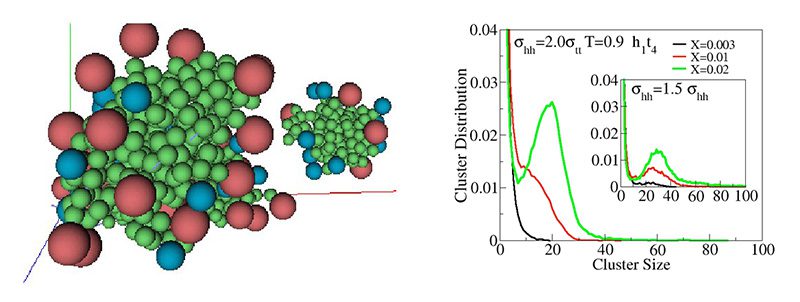
- Phase diagram of complex molecules using Gibbs Ensemble Monte Carlo: Quite naturally, we have extended the above calculations to find how packing constraints affect the phase diagram of amphiphiles with different hydrophilic heads. This is a natural generalization of applying Gibbs ensemble Monte Carlo method pioneered by Panagiotopolous and co-workers who applied this technique to polymers and amphiphiles on lattice. The accompanying figure shows how the critical point shifts in the temperature-density plane.
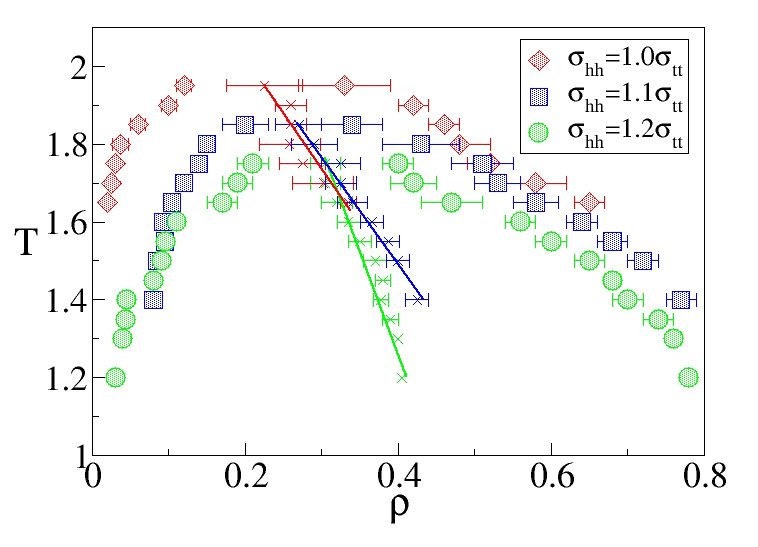
- Statistical Mechanics of Lattice Amphiphiles: Apart from carrying out Molecular dynamics and Monte Carlo calculations for models in continuum, we have also investigated amphiphiles on a lattice as shown in the figure. These calculations are order of magnitude faster, solvents molecules, which are eliminated in continuum calculations, here can be kept at no additional cost, and for certain properties lattice models are as good as their off-lattice counterparts. The figure on the left and right shows depiction of lattice amphiphiles and vesicle formation respectively.
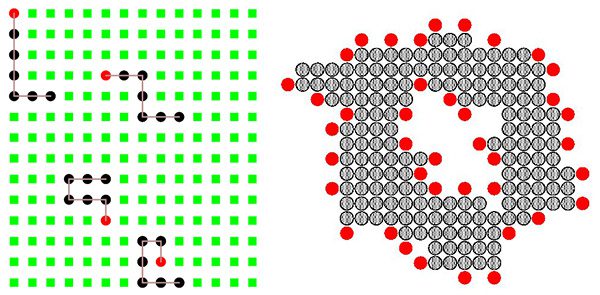
Modeling Ionomers: Self-healing materials, artificial muscles, & Coulomb gel
Ionomers are polymers having a tiny fraction of charges at the backbone and equal numbers of counter-ions present in the vicinity for charge neutrality. Attractive Coulomb interaction among opposite ions pairs gives rise to formation of multiplets and bridges, as shown in the figure, responsible for gel like properties even at very low concentration. Ionomers also exhibit unusual shear thinning behavior and other anomalous viscoelastic properties. They are potential candidates for artificial muscles, fuel cell membranes, and self-healing materials to design exterior body of space-crafts. At a fundamental level, glass transition and formation of Coulomb gels in these systems is a nearly unexplored field. Unlike previous studies, we have developed modes for ionomers with explicit incorporation of ions and counter-ions and plan to make an in depth study of the structure-function relationship in these systems. The figure (right) shows a snapshot of formation of multiples from our simulation.
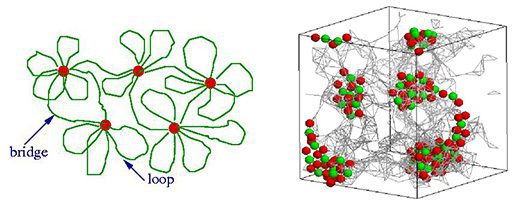
Polymer Depletion Interaction between a Colloid Particle and a Wall
The polymer-induced depletion interaction between mesoscopic colloid particles in a solution of non-adsorbing polymer chains is of fundamental interest in colloid physics. For entropic reasons the chains avoid the space between two close particles, or between a particle and a planar wall, and create an effective attraction among the colloid particles, or push the particles toward the walls of the container. This depletion interaction has been used to explain phase diagrams of colloid-polymer mixtures and is believed to be important for a variety of interesting colloid systems such as casein micelles, hemoglubine, and globular proteins. We have used an off-lattice bead-spring model of a polymer solution in a container with impenetrable walls to study the depletion interaction of a colloid particle with the planar wall by means of a Monte Carlo simulation. As expected, this interaction is found to depend essentially on the ratio R/Rg of the particle radius R to the mean radius of gyration Rg of the polymer chains in the case of dilute and semi-dilute solutions.
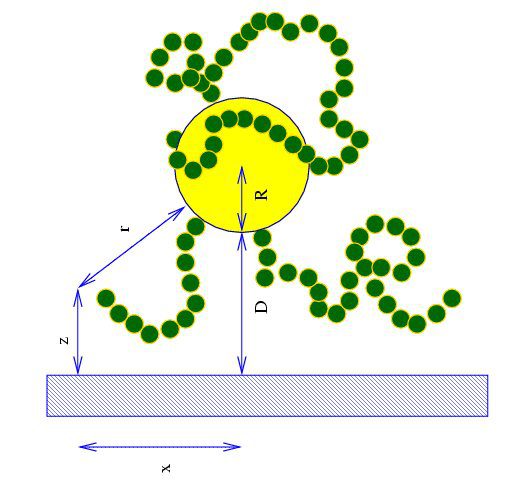
Conformation and Drift of Polymer Chain in Disordered Media
The driven diffusion of an entangled polymer in disordered media is a theoretical problem that has received much attention because of its close connection to Biology. The enormous motivation stems from the prospect of high speed detection of sequences in a single polynucleotide molecule. As a result, the behavior of large flexible molecules e.g., DNA, RNA, proteins, and synthetic polyelectrolytes in disordered porous media offers many challenges and excitement to the scientific community. Therefore, it is rather important to identify different mechanism of transportation of polymers as it moves through a disordered medium where the chain entanglement effect plays a crucial role.\par We have examined the properties of an end-labeled telechelic polymer chain where only the first monomer of the chain is influenced by an external force using a stochastic molecular dynamics simulation method. and calculated the dynamic properties of the chain directly from the simulation as a function of bias and impurity density as well.
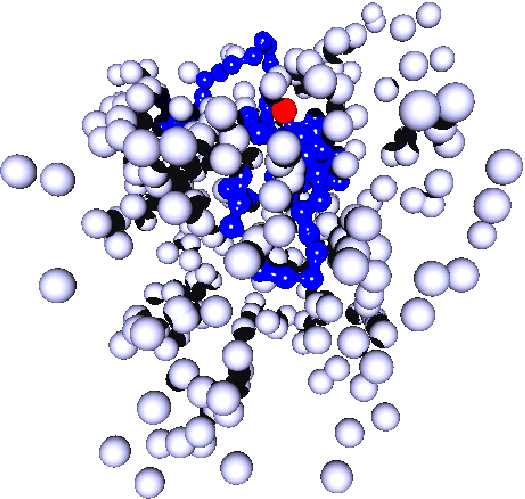
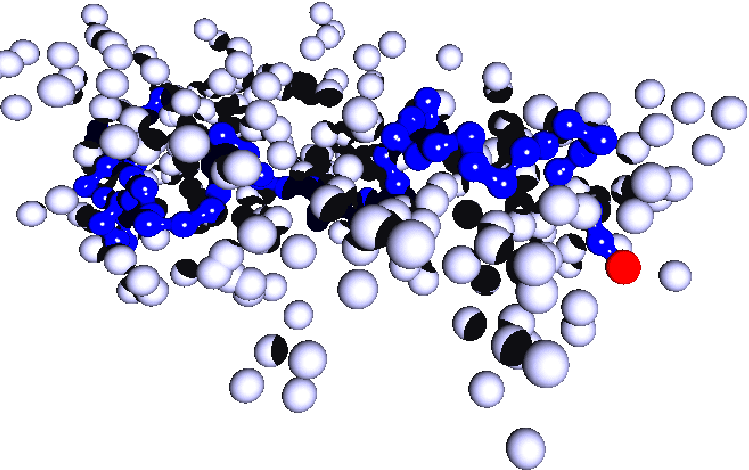
Conformations of a telechelic chain of length N=64 in porous media with rho_imp= 0.1. In both cases the external field points from left to the right. The top snapshot shows a situation where the rest of the chain has overtaken the immobile head which has got stuck between obstacles. The left snapshot displays a freely drifting chain among obstacles. Most of the obstacles have been removed for better visibility.
Patterns from a single seed using Slippery Ballistic Deposition
Our recent studies of pattern formation from a slippery ballistic deposition (SBD) model where growth germinates from a single site or from sites distributed periodically on a lattice exhibits novel patterns.

By changing the sticking probability p_s and choosing systems with different lattice constants and symmetries, we demonstrate that a variety of novel patterns can be generated. These patterns can be further used as scaffolds for nano-fabrication. We also demonstrate that by choosing a lateral sticking probability $p_l$ at the base which is different than $p_s$, one can control both the early and late time morphologies originating from a seed.

Furthermore, we indicate a possible generalization of preparing novel patterns to higher dimensions that in principle can have potential technological applications to prepare grooves and scaffolds of specific shapes and periodicities.
Phase Ordering Dynamics in the Bulk and Restricted Geometries
Systems quenched from a high temperature disordered state to a low temperature ordered state do not order instantly. Different broken symmetric states come into competition to select the final equilibrium state. Coarsening or phase ordering dynamics is the study of evolution of the system towards the final equilibrium configuration. At late time typically a single length scale R(t), which is the average distance between the defects governs the late time phase ordering dynamics and other microscopic details become irrelevant. The system enters into a scaling regime. The domain size R(t) ~ t 1/z, and the equal time pair correlation function C(r,t) takes a simple scaling form f(r/R(t)).
A rather different picture emerges when the phase separating system is confined in restricted geometries. We have studied the phase ordering dynamics of a binary liquid mixture and nematic liquid crystals in restricted geometries under different surface anchoring conditions. We find that depending upon the symmetry and the conservation laws of the order parameter, geometric confinement and surface anchoring have marked impact on the growth dynamics.
We have extended these calculations from simple mixture to a phase separating polymer solution where the coarsening process gets more complicated by chain conformations and entanglement effects. Our simulations strongly indicate that the true late time growth kinetics of quenched polymer solutions belong to the same universality class of small molecular mixtures.
Following the general theme, the above study has been extended to the case where polymers are confined in a long and narrow cylindrical pore subject to an attractive wall potential. We find that for deep quenches the uniform density state breaks up into alternate polymer rich phase in the form of plugs and the solvent rich phase.
Selective Publications on phase ordering dynamics:
- Aniket Bhattacharya, S. D. Mahanti, and Amitabha Chakrabarti,
Networklike Pattern Formation in Phase Separating Polymer Solutions: a Molecular Dynamics Study,
Phys. Rev. Lett. 80, 333 (1998). - Aniket Bhattacharya, Madan Rao, and A. Chakarabarti,
Kinetics of phase ordering of nematic liquid crystals in a confined geometry
Phys. Rev. E 53, 4899 (1996). - Aniket Bhattacharya, Madan Rao, and Amitabha Chakrabarti,
Phase separation in binary mixtures confined in a strip geometry,
Phys. Rev. E 49, 524 (1994).